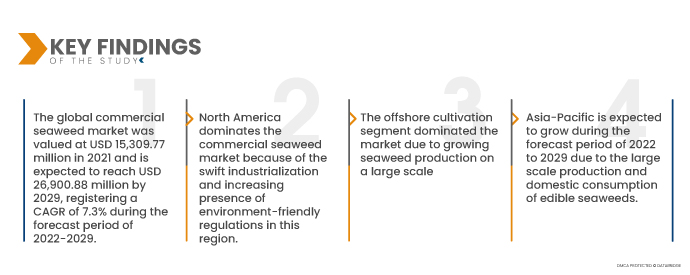لقد لوحظ على مر السنين أن أمراض القلب والأوعية الدموية تُعد السبب الرئيسي للوفاة عالميًا، حيث تُصيب حوالي 423 مليون شخص. ويُصيب داء السكري 463 مليون شخص حول العالم، ومن المتوقع أن يرتفع هذا العدد إلى 642 مليونًا بحلول عام 2040. للأعشاب البحرية فوائد صحية عديدة. تُعتبر السمنة مشكلة صحية رئيسية تؤثر على الناس حول العالم، وقد ارتبطت بظهور مجموعة من الأمراض المزمنة. تتميز الأعشاب البحرية التجارية بانخفاض سعراتها الحرارية وغنى أليافها، مما يجعلها مناسبة لفقدان الوزن وتقليل خطر الإصابة بأمراض القلب والأوعية الدموية وداء السكري.
تشير تحليلات شركة داتا بريدج لأبحاث السوق إلى أن قيمة سوق الأعشاب البحرية التجارية العالمية بلغت 15,309.77 مليون دولار أمريكي في عام 2021، ومن المتوقع أن تصل إلى 26,900.88 مليون دولار أمريكي بحلول عام 2029، مسجلةً معدل نمو سنوي مركب قدره 7.3% خلال الفترة المتوقعة 2022-2029. وسيوفر الطلب المتزايد على الأعشاب البحرية التجارية فرصًا محتملة لنمو السوق خلال الفترة المتوقعة.
من المتوقع أن يؤدي العدد المتزايد من الأعشاب البحرية في قطاع الأغذية والمشروبات إلى دفع معدل نمو السوق
تحتوي الأعشاب البحرية على جميع أنواع الفيتامينات والبروتينات والمعادن والألياف ومضادات الأكسدة، مما يُعزز سوقها. ويتزايد الطلب على الأعشاب البحرية في قطاع الأغذية والمشروبات. فهي غنية بالألياف، وتساعد على إنقاص الوزن. وبالتالي، فإن تزايد الوعي الصحي لدى السكان والتوجه نحو نمط حياة صحي يُعزز سوقها. كما أن الطلب المتزايد على الأعشاب البحرية في الأغذية والمشروبات بين المستهلكين يُتيح للمصنعين طرح منتجات جديدة في السوق.
على سبيل المثال،
- في عام ٢٠٢١، أطلقت شركة كارغيل مسحوق أعشاب بحرية ضمن خط منتجات WavePure ADG، وفقًا لـ FoodIngredientsFirst. يُصنع هذا المسحوق من أعشاب Gracilaria البحرية الحمراء لتعزيز نعومة وملمس منتجات الألبان الكريمي.
نطاق التقرير وتقسيم السوق
مقياس التقرير
|
تفاصيل
|
فترة التنبؤ
|
من 2022 إلى 2029
|
سنة الأساس
|
2021
|
السنوات التاريخية
|
2020 (قابلة للتخصيص من 2014 إلى 2019)
|
الوحدات الكمية
|
الإيرادات بالملايين من الدولارات الأمريكية، والحجم بالوحدات، والتسعير بالدولار الأمريكي
|
القطاعات المغطاة
|
المنتج (الأعشاب البحرية الحمراء والخضراء والبنية)، الشكل (سائل، مسحوق، ورقائق)، الزراعة (زراعة برية، زراعة بحرية، زراعة قريبة من الشاطئ، زراعة IMTA، تربية الأحياء المائية المالحة)، المستخدم النهائي (الأغذية والمشروبات، الأدوية، الزراعة، أعلاف الحيوانات ، مستحضرات التجميل والعناية الشخصية، الوقود الحيوي وغيرها)
|
الدول المغطاة
|
الولايات المتحدة الأمريكية، كندا، المكسيك في أمريكا الشمالية، ألمانيا، السويد، بولندا، الدنمارك، إيطاليا، المملكة المتحدة، فرنسا، إسبانيا، هولندا، بلجيكا، سويسرا، تركيا، روسيا، بقية دول أوروبا في أوروبا، اليابان، الصين، الهند، كوريا الجنوبية، نيوزيلندا، فيتنام، أستراليا، سنغافورة، ماليزيا، تايلاند، إندونيسيا، الفلبين، بقية دول آسيا والمحيط الهادئ (APAC) في آسيا والمحيط الهادئ (APAC)، البرازيل، الأرجنتين، بقية دول أمريكا الجنوبية كجزء من أمريكا الجنوبية، الإمارات العربية المتحدة، المملكة العربية السعودية، عُمان، قطر، الكويت، جنوب أفريقيا، بقية دول الشرق الأوسط وأفريقيا (MEA) كجزء من الشرق الأوسط وأفريقيا (MEA)
|
الجهات الفاعلة في السوق المغطاة
|
كارغيل، إنكوربوريتد (الولايات المتحدة)، دوبونت (الولايات المتحدة)، أتسينوفا (إيطاليا)، شركة بكين ليلي الزراعية المحدودة (بكين)، الأعشاب البحرية الأيرلندية (المملكة المتحدة)، أوشن رينفورست (الولايات المتحدة)، خضراوات ساحل مين البحرية (الولايات المتحدة)، كيلب إندستريز المحدودة (أستراليا)، جرين أوشن فارمنج (المملكة المتحدة)، شركة الأعشاب البحرية (الهند)، كاسكاديا الأعشاب البحرية (كندا)، كوانغتشيون كيم (كوريا الجنوبية)
|
نقاط البيانات التي يغطيها التقرير
|
بالإضافة إلى الرؤى حول سيناريوهات السوق مثل القيمة السوقية ومعدل النمو والتجزئة والتغطية الجغرافية واللاعبين الرئيسيين، تتضمن تقارير السوق التي أعدتها شركة Data Bridge Market Research أيضًا تحليلًا متعمقًا من الخبراء والإنتاج والقدرة التمثيلية الجغرافية للشركة وتخطيطات الشبكة للموزعين والشركاء وتحليل اتجاهات الأسعار التفصيلية والمحدثة وتحليل العجز في سلسلة التوريد والطلب.
|
تحليل القطاعات:
يتم تقسيم السوق العالمية للأعشاب البحرية التجارية إلى أربعة قطاعات بارزة تعتمد على المنتج والشكل والزراعة والمستخدم النهائي.
- على أساس المنتج، يتم تقسيم سوق الأعشاب البحرية التجارية إلى الأعشاب البحرية الحمراء والأعشاب البحرية الخضراء والأعشاب البحرية البنية.
من المتوقع أن تهيمن شريحة الأعشاب البحرية البنية من نوع المنتج على سوق الأعشاب البحرية التجارية
ومن المتوقع أن تهيمن الأعشاب البحرية البنية على القطاع بحصة سوقية تبلغ 59.28% بسبب عوامل مثل الوعي المتزايد حول الفوائد الصحية التي توفرها الأعشاب البحرية البنية وزيادة الطلب على المزيد من المنتجات الطبيعية والعضوية.
- على أساس الشكل، يتم تقسيم سوق الأعشاب البحرية التجارية إلى سائلة ومسحوقة ورقائق.
من المتوقع أن تهيمن شريحة المسحوق من نوع النموذج على سوق الأعشاب البحرية التجارية
ومن المتوقع أن يهيمن المسحوق على القطاع بحصة سوقية تبلغ 79.21٪ بسبب الوعي المتزايد المتعلق بالفوائد الصحية للمنتج الذي شق طريقه إلى العديد من الصناعات مثل الأدوية والأغذية والمشروبات والزراعة وغيرها.
- بناءً على الزراعة، يُقسّم سوق الأعشاب البحرية التجارية إلى زراعة برية، وزراعة بحرية، وزراعة قريبة من الشاطئ، وزراعة IMTA، وتربية الأحياء المائية المالحة. ومن المتوقع أن تهيمن الزراعة البحرية على هذا القطاع بحصة سوقية تبلغ 61.31%، وذلك بفضل عوامل مثل تزايد الطلب على الأعشاب البحرية التجارية والاهتمام المتزايد بزراعة الأعشاب البحرية على نطاق واسع.
- بناءً على المستخدم النهائي، يُقسّم سوق الأعشاب البحرية التجارية إلى قطاعات الأغذية والمشروبات، والأدوية، والزراعة، وأعلاف الحيوانات، ومستحضرات التجميل والعناية الشخصية، والوقود الحيوي. ومن المتوقع أن يهيمن قطاع الأغذية والمشروبات على هذا القطاع بحصة سوقية تبلغ 35.38%، وذلك بفضل عوامل مثل تزايد الوعي بالقيمة الغذائية والفوائد الصحية التي توفرها الأعشاب البحرية، وزيادة الطلب على منتجات الأغذية والمشروبات الطبيعية والعضوية.
اللاعبون الرئيسيون
تعترف شركة Data Bridge Market Research بالشركات التالية باعتبارها اللاعبين الرئيسيين في سوق الأعشاب البحرية التجارية وهي Cargill، Incorporated (الولايات المتحدة)، وDuPont (الولايات المتحدة)، وAtSeNova (إيطاليا)، وBeijing Leili Agriculture Co.، Ltd (بكين)، وIrish Seaweed (المملكة المتحدة)، وOcean Rainforest (الولايات المتحدة)، وMaine Coast Sea Vegetables (الولايات المتحدة)، وKelp Industries، Pty، Ltd. (أستراليا)، وGreen Ocean Farming (المملكة المتحدة)، وThe Seaweed Company (الهند)، وCascadia Seaweed (كندا)، وKwangcheonKim (كوريا الجنوبية).

تطوير السوق
- في عام ٢٠٢١، أطلقت شركة أكاديان سي بلس منتجها الجديد من طحالب كوندراكانثوس شاميسوي البحرية. وهو نوع من الطحالب الحمراء يُستخدم في مجموعة واسعة من المنتجات، بما في ذلك الأغذية الوظيفية، ومستحضرات التجميل، والمكملات الغذائية، والأدوية، وصناعة البيرة. وقد ساهم ذلك في توسيع خط إنتاج الشركة.
- في عام ٢٠٢١، تعاونت شركة كاسكاديا للأعشاب البحرية مع أمة تساووت الأولى لزراعة الأعشاب البحرية قبالة ساحل جزيرة جيمس. وقد ساعد ذلك الشركة على زيادة إنتاج الأعشاب البحرية لتلبية الطلب المتزايد عليها.
التحليل الإقليمي
جغرافيًا، البلدان التي يغطيها تقرير سوق الأعشاب البحرية التجارية هي الولايات المتحدة وكندا والمكسيك في أمريكا الشمالية وألمانيا والسويد وبولندا والدنمارك وإيطاليا والمملكة المتحدة وفرنسا وإسبانيا وهولندا وبلجيكا وسويسرا وتركيا وروسيا وبقية دول أوروبا في أوروبا واليابان والصين والهند وكوريا الجنوبية ونيوزيلندا وفيتنام وأستراليا وسنغافورة وماليزيا وتايلاند وإندونيسيا والفلبين وبقية دول آسيا والمحيط الهادئ (APAC) في آسيا والمحيط الهادئ (APAC) والبرازيل والأرجنتين وبقية دول أمريكا الجنوبية كجزء من أمريكا الجنوبية والإمارات العربية المتحدة والمملكة العربية السعودية وعمان وقطر والكويت وجنوب إفريقيا وبقية دول الشرق الأوسط وأفريقيا (MEA) كجزء من الشرق الأوسط وأفريقيا (MEA).
وفقًا لتحليل Data Bridge Market Research:
أمريكا الشمالية هي المنطقة المهيمنة في سوق الأعشاب البحرية التجارية خلال الفترة المتوقعة من 2022 إلى 2029
تُهيمن أمريكا الشمالية على سوق الأعشاب البحرية التجارية بفضل التصنيع السريع ووجود لوائح صديقة للبيئة في هذه المنطقة. وتتمتع الولايات المتحدة بأكبر حصة سوقية في أمريكا الشمالية بفضل الاستخدام المتزايد للأعشاب البحرية في صناعات الأدوية والعناية الشخصية.
من المتوقع أن تكون منطقة آسيا والمحيط الهادئ أسرع المناطق نموًا في سوق الأعشاب البحرية التجارية خلال الفترة المتوقعة من 2022 إلى 2029
من المتوقع أن تشهد منطقة آسيا والمحيط الهادئ نموًا خلال الفترة المتوقعة من عام ٢٠٢٢ إلى عام ٢٠٢٩، نظرًا للإنتاج الضخم والاستهلاك المحلي للأعشاب البحرية الصالحة للأكل في هذه المنطقة. ومن المتوقع أن تستحوذ الصين على أكبر حصة سوقية بفضل تزايد زراعة الأعشاب البحرية في البلاد وارتفاع الطلب عليها من المستخدمين النهائيين في هذه المنطقة.
لمزيد من المعلومات التفصيلية حول تقرير سوق الأعشاب البحرية التجارية، انقر هنا - https://www.databridgemarketresearch.com/reports/global-commercial-seaweeds-market











